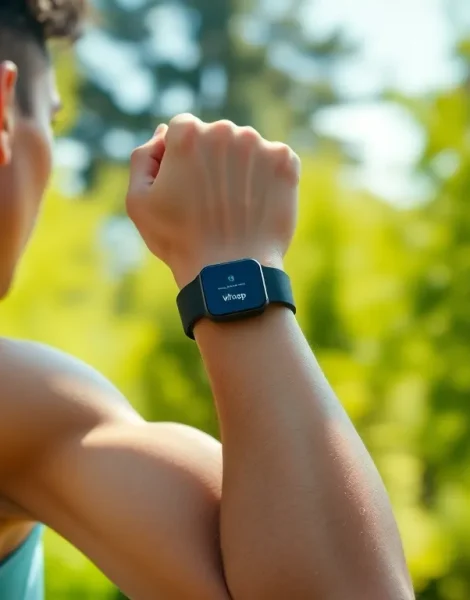In a world where fitness trackers often feel like glorified pedometers, the Whoop fitness band struts onto the scene like a personal trainer who moonlights as a comedian. This sleek device doesn’t just count steps; it dives deep into your body’s performance metrics, revealing insights that even your gym buddy might envy. With Whoop, it’s like having a fitness guru wrapped around your wrist, ready to dish out advice without the annoying motivational speeches.
What sets Whoop apart is its focus on recovery and strain, making it the ultimate wingman for anyone serious about their fitness journey. Forget about those flashy screens and constant notifications; Whoop keeps it simple and effective. It’s all about understanding your body’s needs, helping you crush those goals while still managing to enjoy a slice of pizza guilt-free. If you’re ready to take your training to the next level, Whoop might just be the secret weapon you’ve been searching for.
Table of Contents
ToggleOverview of Whoop Fitness Band
Whoop fitness band offers advanced features tailored for athletes and fitness enthusiasts. This band tracks key performance metrics like recovery, strain, and sleep. Users benefit from its emphasis on recovery, enabling them to optimize their training routines effectively.
Data collected by Whoop provides insights essential for understanding body performance on a daily basis. Metrics include heart rate variability, resting heart rate, and sleep quality. These metrics contribute significantly to achieving specific fitness goals.
Simplicity defines the Whoop experience. It does not include a screen; instead, it relies on an intuitive app for data analysis. This design promotes a seamless understanding of personal health analytics without distractions.
Subscription-based access enhances the user experience. Members receive ongoing analysis of their performance metrics and personalized recommendations. As individuals track progress over time, they can adjust workouts and recovery strategies accordingly.
Whoop’s community features encourage engagement. Users can join challenges and share insights with friends, adding a social element to fitness tracking. Interaction with others can foster motivation and accountability.
Durability is another important aspect. The band is designed for various environments, from the gym to outdoor activities, ensuring that it withstands different conditions. Waterproof capabilities make it suitable for swimming and other water sports.
Overall, Whoop stands out among fitness trackers by prioritizing recovery and strain analysis. Its commitment to continuous improvement sets it apart in the fitness technology landscape.
Features of Whoop Fitness Band

The Whoop fitness band integrates essential health metrics into a cohesive system, offering users comprehensive insights into their physical state.
Heart Rate Monitoring
Heart rate monitoring serves as a cornerstone feature. Whoop continuously tracks heart rate, providing real-time data during workouts and daily activities. This capability highlights fluctuations in heart rate variability (HRV), crucial for assessing fitness levels. Users gain valuable insights into exertion during exercise and recovery periods, which can enhance training efficiency. Equipped with advanced sensors, the band accurately captures data, promoting informed decisions about fitness and recovery.
Sleep Tracking
Sleep tracking delivers a detailed analysis of nightly rest cycles. Using sophisticated algorithms, Whoop evaluates sleep quality, duration, and disturbances, enabling users to understand their sleep patterns better. Information about deep sleep and REM stages helps identify areas for improvement. Armed with this knowledge, individuals can adjust bedtime routines and lifestyle choices to enhance recovery. Ultimately, effective sleep tracking empowers users to maximize their performance gains through restorative sleep.
Recovery Insights
Recovery insights play a critical role in the Whoop experience. The band analyzes heart rate variability, resting heart rate, and sleep quality to generate daily recovery scores. This score offers a snapshot of overall readiness for physical activity, helping users understand when to push hard or prioritize rest. Recommendations derived from recovery data encourage optimal training loads and allow users to avoid overtraining. Overall, recovery insights enable fitness enthusiasts to strike a balance between activity and recovery, fostering long-term health and performance improvements.
Pros and Cons of Whoop Fitness Band
Whoop fitness band presents a unique set of advantages and disadvantages worth considering.
Advantages
Whoop’s standout feature includes continuous heart rate monitoring. This provides real-time data crucial for understanding fitness levels. Additionally, recovery insights generated daily guide users on optimal training intensity. The band focuses on sleep tracking as well, offering detailed analyses to improve sleep quality. Users benefit from a subscription model that enhances personalized recommendations and ongoing data analysis. Community features promote engagement, encouraging users to partake in challenges and share progress. Durability marks another advantage, as the band withstands various environments, including water settings.
Disadvantages
One notable disadvantage involves the subscription-based model, which may deter budget-conscious users. Monthly fees accumulate over time, impacting long-term affordability. Without a display, immediate access to stats can pose a challenge for some users. Additionally, the absence of built-in GPS means relying on smartphone connectivity for location tracking. Customization options are limited compared to other fitness trackers, which can be frustrating for those seeking personalization. Overall, these factors may influence user experience and satisfaction with Whoop fitness band.
Comparison with Other Fitness Bands
Whoop fitness band distinguishes itself from competitors through its emphasis on recovery metrics. Many typical fitness bands focus primarily on step counting and calorie tracking. Users looking for deeper insights prefer the Whoop band’s comprehensive data analysis.
Fitbit offers a variety of models, providing features like a built-in display and sleep tracking. However, Fitbit devices often prioritize general fitness tracking over detailed recovery analytics, which Whoop excels in. Garmin focuses on advanced GPS features, which suits outdoor enthusiasts, yet it may lack the recovery insights that serious athletes need.
Apple Watch encompasses a wide range of features, combining fitness tracking with smartwatch capabilities. While it includes heart rate monitoring and activity tracking, Whoop targets a narrower audience focused on performance optimization. Polar also specializes in heart rate monitors, yet its offerings do not provide the same recovery-focused framework as Whoop.
Another factor to consider is the subscription model implemented by Whoop. Unlike most fitness bands that only require an initial purchase, Whoop’s model provides ongoing analytics and personalized recommendations. This aspect can present a financial consideration for some users but ensures a continuous flow of relevant information.
Durability stands out as a shared trait across fitness bands, but Whoop’s waterproof features enhance its appeal for users engaged in water sports. Each device offers unique strengths, but few complement extensive health insights with a community-driven experience like Whoop. By focusing on personalized recovery and strain analysis, Whoop appeals to fitness enthusiasts aiming for improved performance through detailed metrics.
User Experience and Testimonials
Users appreciate the Whoop fitness band’s focus on in-depth performance metrics. Many report significant improvements in their training routines, attributing this to the recovery insights provided daily. Evaluating heart rate variability and sleep quality offers personalized recommendations, which enhances workout efficiency.
Feedback often highlights the user-friendly app, hailed for its intuitive design. Tracking metrics like strain and recovery becomes hassle-free, allowing effortless navigation. Individuals value the continuous heart rate monitoring feature, which enables real-time adjustments during workouts.
Durability in various environments adds to customer satisfaction. The waterproof design appeals to users involved in swimming and other water activities. Users also enjoy the community aspect, finding motivation in shared challenges and social connections within the app.
Testimonials reflect a common theme: the Whoop fitness band effectively promotes accountability. Some users express mixed feelings about the subscription model, citing concerns over additional costs, yet many recognize its value in delivering ongoing analytics. Ease of access to deep insights outweighs the lack of on-device display for immediate stats.
When comparing Whoop to competitors, users often describe it as a game changer for serious athletes. Prioritizing recovery over general fitness tracking sets it apart from brands like Fitbit and Garmin. Testimonials emphasize the advantage of focusing on performance optimization, catering to those aiming for peak athleticism.
The Whoop fitness band stands out in the crowded market of fitness trackers by prioritizing recovery and performance metrics over standard features. Its focus on continuous heart rate monitoring and in-depth sleep analysis empowers users to optimize their training and recovery effectively. The seamless integration of data through an intuitive app enhances the overall user experience, making it a valuable tool for serious athletes.
While the subscription model may raise concerns for some, the personalized insights and ongoing analytics justify the investment for many. Users appreciate the band’s durability and waterproof design, which complements a variety of activities. Overall, Whoop is a transformative device that can significantly impact fitness routines, encouraging users to listen to their bodies and train smarter.









